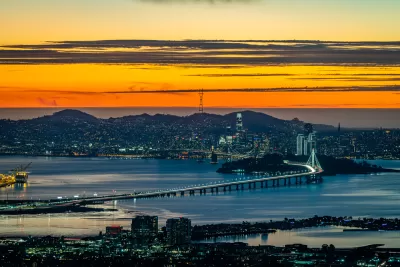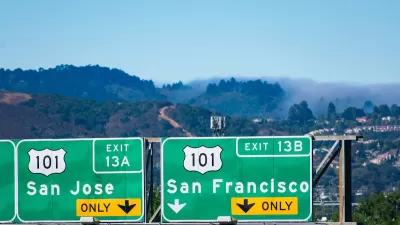The SPUR Regional Strategy sets a new standard for planning advocacy, not only for the depth and breadth of its vision, but for its skill in execution.

SPUR released an ambitious, colorful new Regional Strategy this week that sets a new standard for planning advocacy.
The results of three years of work includes policy research and analysis on housing, growth, economic justice, climate, and transportation—all supplemented with digital storytelling created by Art+Action in collaboration with Emotive Brand. At least 20 artists, designers, animators, and other creatives contributed to the report, according to the report's credits.
The entire SPUR Strategic Vision is organized into four "invitations": 1) Reimagine our housing policies; 2) Grow up, not out; 3) Close the racial wealth and well-being gap; and 4) Protect our region and all its inhabitants from climate change. A total of 25 reports comprise the entire SUPR Regional Plan.
As for the substance of the SPUR Regional Strategy, San Francisco Chronicle reporter J.K. Dineen offers this summary:
The Bay Area of 2070 would be a place where homeless encampments are a thing of the past. Builders would be allowed to construct three- or four-unit buildings in suburban single-family neighborhoods. Speculators would no longer be able to evict tenants in order to convert apartments to condos.
And new housing would not gobble up precious farm land in counties like San Joaquin or Contra Costa, but would be built mostly in five-story buildings in historic downtowns like Alameda, Fairfield, Mountain View, Pleasanton and Santa Rosa.
As Dineen explains, the Regional Strategy lays out a 50-year vision for the region, with 175 policy recommendations in all, touching "on everything from rent control to rapid bus lines to protecting against sea level rise."
"The SPUR reports compare two scenarios: 'business as usual,' based on current zoning and land-use patterns; and a 'new civic vision,' which imagines a more equitable and sustainable region with reformed land-use regulations," according to Dineen. The new civic vision referenced here is laid out in its own separate document available online.
The report plans for 4 million new residents in the Bay Area by 2070, and targets a need for 2.2 million new housing units. The "business as usual" land-use planning in place in the cities and counties comprising the region would likely produce 1.4 million housing units, explains Dineen, "and much of that would be put in the wrong places — farmland and open areas that are far from transit."
Dineen's article, linked below, includes a lot more detail on the differences between the business-as-usual approach and the new civic vision outlined by SPUR.
FULL STORY: Could the Bay Area solve its housing crisis by building in city centers? An S.F. group thinks so

Study: Maui’s Plan to Convert Vacation Rentals to Long-Term Housing Could Cause Nearly $1 Billion Economic Loss
The plan would reduce visitor accommodation by 25,% resulting in 1,900 jobs lost.

Alabama: Trump Terminates Settlements for Black Communities Harmed By Raw Sewage
Trump deemed the landmark civil rights agreement “illegal DEI and environmental justice policy.”

Why Should We Subsidize Public Transportation?
Many public transit agencies face financial stress due to rising costs, declining fare revenue, and declining subsidies. Transit advocates must provide a strong business case for increasing public transit funding.

Paris Bike Boom Leads to Steep Drop in Air Pollution
The French city’s air quality has improved dramatically in the past 20 years, coinciding with a growth in cycling.

Why Housing Costs More to Build in California Than in Texas
Hard costs like labor and materials combined with ‘soft’ costs such as permitting make building in the San Francisco Bay Area almost three times as costly as in Texas cities.

San Diego County Sees a Rise in Urban Coyotes
San Diego County experiences a rise in urban coyotes, as sightings become prevalent throughout its urban neighbourhoods and surrounding areas.
Urban Design for Planners 1: Software Tools
This six-course series explores essential urban design concepts using open source software and equips planners with the tools they need to participate fully in the urban design process.
Planning for Universal Design
Learn the tools for implementing Universal Design in planning regulations.
Smith Gee Studio
Alamo Area Metropolitan Planning Organization
City of Santa Clarita
Institute for Housing and Urban Development Studies (IHS)
City of Grandview
Harvard GSD Executive Education
Toledo-Lucas County Plan Commissions
Salt Lake City
NYU Wagner Graduate School of Public Service





























